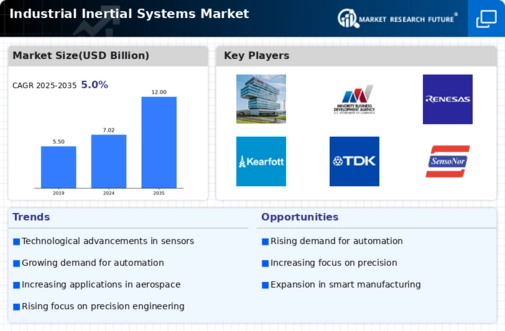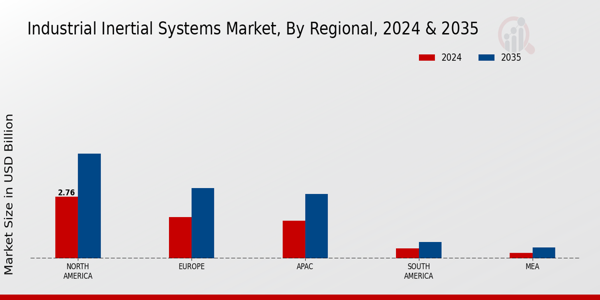Market Growth Chart
Technological Advancements
The Global Industrial Inertial Systems Market Industry is experiencing rapid technological advancements, particularly in sensor technology and data processing capabilities. Innovations in micro-electromechanical systems (MEMS) and fiber optic gyroscopes are enhancing the accuracy and reliability of inertial systems. These advancements are crucial for applications in aerospace, automotive, and robotics, where precision is paramount. As a result, the market is projected to reach 7.02 USD Billion in 2024, reflecting the growing demand for sophisticated inertial navigation systems that can operate in challenging environments.
Growing Demand for Automation
The increasing trend towards automation across various industries is driving the Global Industrial Inertial Systems Market Industry. Industries such as manufacturing, logistics, and transportation are increasingly adopting automated systems to enhance efficiency and reduce operational costs. Inertial systems play a vital role in these automated processes by providing accurate positioning and navigation data. This demand is expected to contribute to a compound annual growth rate of 4.99% from 2025 to 2035, indicating a robust growth trajectory as industries seek to integrate advanced technologies into their operations.
Rising Need for Safety and Security
Safety and security concerns are becoming increasingly prominent in the Global Industrial Inertial Systems Market Industry. Industries such as aerospace and defense are prioritizing the integration of inertial systems to enhance situational awareness and improve safety protocols. For instance, inertial navigation systems are critical in military applications for precise targeting and navigation. This heightened focus on safety is likely to propel the market towards an estimated value of 12 USD Billion by 2035, as organizations invest in technologies that mitigate risks and enhance operational safety.
Expansion of Aerospace and Defense Sectors
The expansion of the aerospace and defense sectors is a significant driver for the Global Industrial Inertial Systems Market Industry. With increasing investments in military modernization and commercial aviation, the demand for advanced inertial systems is surging. These systems are essential for navigation, guidance, and control in various aerospace applications. The growth in air travel and defense spending is expected to sustain this momentum, contributing to the market's growth as it adapts to the evolving needs of these critical sectors.
Emerging Applications in Robotics and Autonomous Vehicles
Emerging applications in robotics and autonomous vehicles are reshaping the Global Industrial Inertial Systems Market Industry. As industries explore the potential of autonomous systems for tasks ranging from warehouse automation to self-driving cars, inertial systems are becoming indispensable for navigation and control. The integration of inertial sensors in these applications enhances operational efficiency and reliability. This trend is likely to drive market growth as companies invest in innovative solutions to meet the demands of an increasingly automated future.














